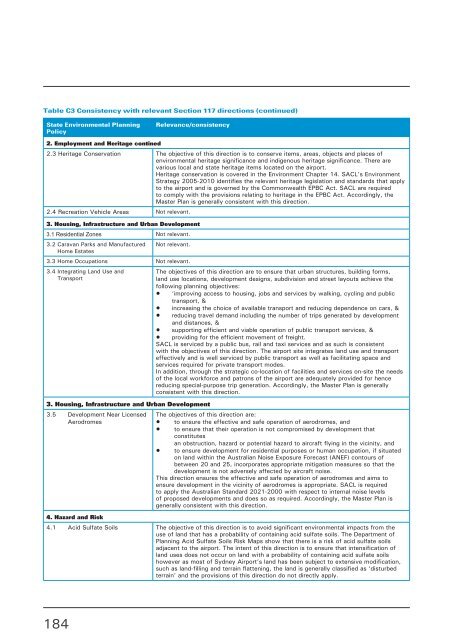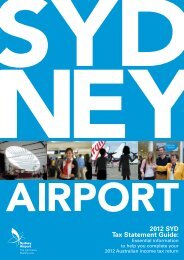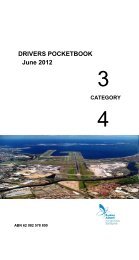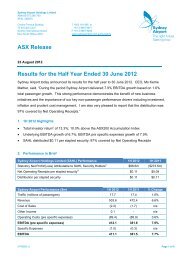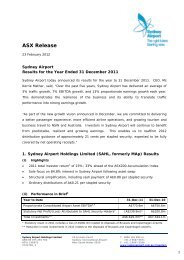Master Plan 2009 - Sydney Airport
Master Plan 2009 - Sydney Airport
Master Plan 2009 - Sydney Airport
You also want an ePaper? Increase the reach of your titles
YUMPU automatically turns print PDFs into web optimized ePapers that Google loves.
Table C3 Consistency with relevant Section 117 directions (continued)<br />
State Environmental <strong>Plan</strong>ning<br />
Policy<br />
184<br />
Relevance/consistency<br />
2. Employment and Heritage contined<br />
2.3 Heritage Conservation The objective of this direction is to conserve items, areas, objects and places of<br />
environmental heritage significance and indigenous heritage significance. There are<br />
various local and state heritage items located on the airport.<br />
Heritage conservation is covered in the Environment Chapter 14. SACL’s Environment<br />
Strategy 2005-2010 identifies the relevant heritage legislation and standards that apply<br />
to the airport and is governed by the Commonwealth EPBC Act. SACL are required<br />
to comply with the provisions relating to heritage in the EPBC Act. Accordingly, the<br />
<strong>Master</strong> <strong>Plan</strong> is generally consistent with this direction.<br />
2.4 Recreation Vehicle Areas Not relevant.<br />
3. Housing, Infrastructure and Urban Development<br />
3.1 Residential Zones Not relevant.<br />
3.2 Caravan Parks and Manufactured Not relevant.<br />
Home Estates<br />
3.3 Home Occupations Not relevant.<br />
3.4 Integrating Land Use and<br />
The objectives of this direction are to ensure that urban structures, building forms,<br />
Transport<br />
land use locations, development designs, subdivision and street layouts achieve the<br />
following planning objectives:<br />
• ‘improving access to housing, jobs and services by walking, cycling and public<br />
transport, &<br />
• increasing the choice of available transport and reducing dependence on cars, &<br />
• reducing travel demand including the number of trips generated by development<br />
and distances, &<br />
• supporting efficient and viable operation of public transport services, &<br />
• providing for the efficient movement of freight.<br />
SACL is serviced by a public bus, rail and taxi services and as such is consistent<br />
with the objectives of this direction. The airport site integrates land use and transport<br />
effectively and is well serviced by public transport as well as facilitating space and<br />
services required for private transport modes.<br />
In addition, through the strategic co-location of facilities and services on-site the needs<br />
of the local workforce and patrons of the airport are adequately provided for hence<br />
reducing special-purpose trip generation. Accordingly, the <strong>Master</strong> <strong>Plan</strong> is generally<br />
consistent with this direction.<br />
3. Housing, Infrastructure and Urban Development<br />
3.5 Development Near Licensed<br />
Aerodromes<br />
The objectives of this direction are:<br />
• to ensure the effective and safe operation of aerodromes, and<br />
• to ensure that their operation is not compromised by development that<br />
constitutes<br />
an obstruction, hazard or potential hazard to aircraft flying in the vicinity, and<br />
• to ensure development for residential purposes or human occupation, if situated<br />
on land within the Australian Noise Exposure Forecast (ANEF) contours of<br />
between 20 and 25, incorporates appropriate mitigation measures so that the<br />
development is not adversely affected by aircraft noise.<br />
This direction ensures the effective and safe operation of aerodromes and aims to<br />
ensure development in the vicinity of aerodromes is appropriate. SACL is required<br />
to apply the Australian Standard 2021-2000 with respect to internal noise levels<br />
of proposed developments and does so as required. Accordingly, the <strong>Master</strong> <strong>Plan</strong> is<br />
generally consistent with this direction.<br />
4. Hazard and Risk<br />
4.1 Acid Sulfate Soils The objective of this direction is to avoid significant environmental impacts from the<br />
use of land that has a probability of containing acid sulfate soils. The Department of<br />
<strong>Plan</strong>ning Acid Sulfate Soils Risk Maps show that there is a risk of acid sulfate soils<br />
adjacent to the airport. The intent of this direction is to ensure that intensification of<br />
land uses does not occur on land with a probability of containing acid sulfate soils<br />
however as most of <strong>Sydney</strong> <strong>Airport</strong>’s land has been subject to extensive modification,<br />
such as land-filling and terrain flattening, the land is generally classified as ‘disturbed<br />
terrain’ and the provisions of this direction do not directly apply.


